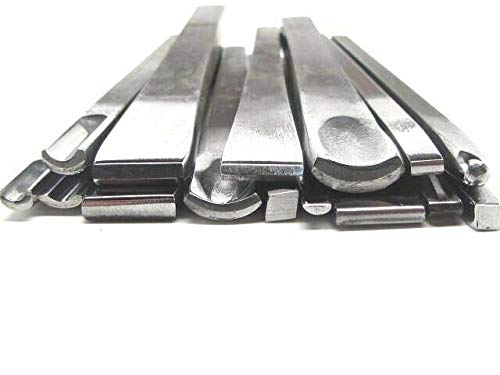What are
/r/SilverSmith's
favorite Products & Services?
From 3.5 billion Reddit comments
The most popular Products mentioned in /r/SilverSmith:
The most popular reviews in /r/SilverSmith:
I have found Silversmithing by Rupert Finegold and William Seitz to be a gold mine of information. There's some stuff that's a bit dated such as the large amounts of Lead he works with but otherwise it's a solid book. The book focuses more of forming metal then jewlery work,but that's what I prefer to do.
I don’t know if you’re still looking, but I bought this lamp for sooo much less than all the other specialty jewelers lamps sell for and I love it! I can see absolutely every little detail at nighttime just the same as I would during the day and you never have to change out any bulbs. I recommend the hell out of it
The bible of jewelry making - Jewelry: Concepts And Technology by Oppi Untracht.
Amazon has it for a good price. It's a little dated (1980s - no 3D printers) but is a huge book that covers Just about everything you need to know in the traditional craft.
Would you recommend using a standard fan like this? https://www.amazon.com/Holmes-Window-Manual-Controls-Settings/dp/B00005CDPH/ref=sr_1_2_mod_primary_new?crid=3NY76FE0SNCQS&keywords=holmes+dual+8+blade+twin+window+fan+with+manual+controls&qid=1643153864&sbo=RZvfv%2F%2FHxDF%2BO5021pAnSA%3D%3D&sprefix=holmes+dual+8%22%2Caps%2C132&sr=8-2 If I have a window in my space where I will be soldering and I was thinking of placing this fan in the window space to suck out fumes.
What about this set of hammers? https://www.riogrande.com/product/fretz-silversmith-hammer-assortment/112459
Did you mean something like this for the spoon stakes? https://www.amazon.com/dp/B07KV8S5PR/ref=cm_sw_r_apan_glt_fabc_X2WSJ6JY4TJWHSS6YHT8?_encoding=UTF8&psc=1
This is extremely easy to clean with Silvo silver polish and a soft rag.
Here is what the product looks like. Link
It’s not very tarnished, it will be fairly easy to clean. Soft rag only though!!
This book is EXCELLENT.
https://www.amazon.ca/Complete-Metalsmith-Illustrated-Handbook/dp/0871922401/ref=nodl_
Generically, it's called loop-in-loop. This one looks like it's been pulled through a drawplate. Commercial names may differ.
I bought this book on Kindle to learn, it's really good. Clear step by step instructions with photos and diagrams.
To make the chain I used 9m of wire to make jump rings, individually fused, stretched into an oval, pinched and folded each jump ring and then weaved them together. The chain would have been a little longer but I ruined a fair amount of jump rings trying to learn how to fuse them.
The weave was the hardest part because it's a really tight pattern and links would break like ten back and I had to undo everything I'd just fine to remove it and re-fuse every time.
You will want to get your hands on the "On Diverse Arts" by Theophilus. It's a medieval book covering every kind of techniques from forging (and choosing good) iron to jewelry making to glass working to... How to make a basilisk.
It's well worth the money to own a paper copy, but you can probably find a downloadable version for free too. The copyrights must have expired centuries ago.
I have a big vent system mounted over my bench, so no. I don't use a mask when soldering. (I also weld at my bench, and I have full face protection for THAT)
However, when using 3M wheels - yes - dust
I helped set up a buddy's crafting space with a 150CFM fan feeding into a charcoal canister since he can't vent outside. It handles what he needs now, and you can daisy chain the fans if he needs more *oomph*.
https://www.amazon.com/iPower-GLFANXEXPSET4D8CHUMD-Controller-Temperature-Ventilation/dp/B07Q3211N8
Hello, I've taken several jewelry/silversmithing classes in college. When polishing we would generally start with files to get off the really rough spots, which you probably don't need to do since your piece is already fairly smoothed and close to finished. Then we'd switch to sandpaper, starting with coarse and working up to finer grits.
Usually after around 600 we would switch to a polishing compound that would be put on a buffing wheel, again working from coarse to fine. I'd start with tripoli, then do white diamond and then red rouge. You have to get an individual buffing brush for each compound so you don't cross contaminate.
If I were you, I would get a domed buffing brush like this from amazon or wherever that you can put in your electric drill and then get some buffing compound. Personally I think tripoli will be enough to get the mirror finish you're after, but if you want to go the extra mile you can go up to red rouge. Be sure you watch some videos on youtube about buffing because it's really easy for the object you're buffing to get out of control and then flung across the room. After you're done buffing it make sure you wash it thoroughly with soap and warm water since you're going to be drinking out of it!
Totally, you can sand flask cast or even just spend $20 on some investment and carve into that. That's how I made this one:
https://www.flickr.com/photos/jobafunky/33992999986/in/album-72157625644500091/ Not perfect but for my first one, not bad either. There's also permanent iron molds that you can get for making variable sized flat bars and round bars for wire drawing. You can also get draw plates for a lot less than $100. Of course the best thing you can do before spending on equipment is educate yourself. So make the first $8.50 you spend on casting be on this book:
If you are ready to get some equipment, then just ask us where. Good suppliers are an asset.
Indian Silversmithing by W. Ben Hunt. He uses tools that are pretty easy to find for the most part, and mostly sticks to 18-22 gauge sheet silver. The book covers Navajo and Zuni art styles. https://www.amazon.com/Indian-Silversmithing-W-Ben-Hunt/dp/0020116802/ref=sr_1_1?ie=UTF8&qid=1504098791&sr=8-1&keywords=indian+silversmithing














